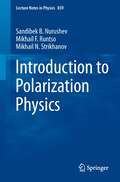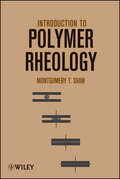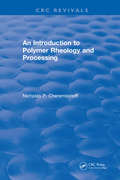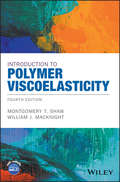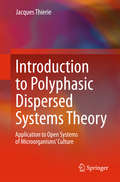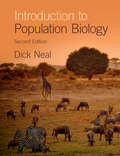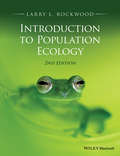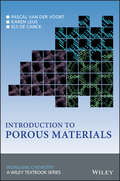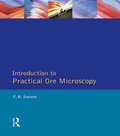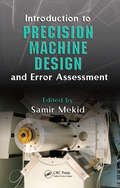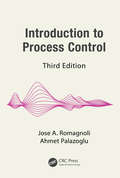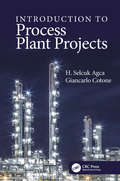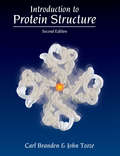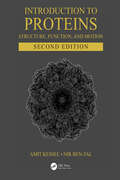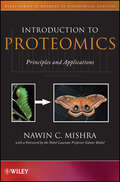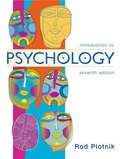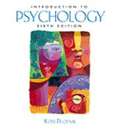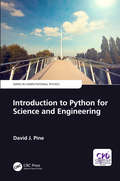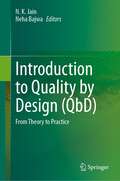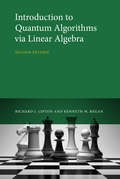- Table View
- List View
Introduction to Plasma Physics: With Space, Laboratory and Astrophysical Applications
by Donald A. Gurnett Amitava BhattacharjeeIntroducing basic principles of plasma physics and their applications to space, laboratory and astrophysical plasmas, this new edition provides updated material throughout. Topics covered include single-particle motions, kinetic theory, magnetohydrodynamics, small amplitude waves in hot and cold plasmas, and collisional effects. New additions include the ponderomotive force, tearing instabilities in resistive plasmas and the magnetorotational instability in accretion disks, charged particle acceleration by shocks, and a more in-depth look at nonlinear phenomena. A broad range of applications are explored: planetary magnetospheres and radiation belts, the confinement and stability of plasmas in fusion devices, the propagation of discontinuities and shock waves in the solar wind, and analysis of various types of plasma waves and instabilities that can occur in planetary magnetospheres and laboratory plasma devices. With step-by-step derivations and self-contained introductions to mathematical methods, this book is ideal as an advanced undergraduate to graduate-level textbook, or as a reference for researchers.
Introduction to Plasma Technology: Science, Engineering, and Applications
by John Ernest HarryWritten by a university lecturer with more than forty years experience in plasma technology, this book adopts a didactic approach in its coverage of the theory, engineering and applications of technological plasmas. The theory is developed in a unified way to enable brevity and clarity, providing readers with the necessary background to assess the factors that affect the behavior of plasmas under different operating conditions. The major part of the book is devoted to the applications of plasma technology and their accompanying engineering aspects, classified by the various pressure and density regimes at which plasmas can be produced. Two chapters on plasma power supplies round off the book. With its broad range of topics, from low to high pressure plasmas, from characterization to modeling, and from materials to components, this is suitable for advanced undergraduates, postgraduates and professionals in the field.
Introduction to Polarization Physics
by Sandibek B. Nurushev Mikhail F. Runtso Mikhail N. StrikhanovThis book is devoted to the polarization (spin) physics of high energy particles and contains three parts. The first part presents the theoretical prefaces of polarization in the particle physics for interpretations, predictions and bases for understanding the following two parts. The second part of the book presents the description of the essential polarization experiments including the recent ones. This part is devoted to the innovative instrumentations, gives the parameters of the polarized beams, targets, polarized gas jets and polarimeters. The third part of the book concentrates on the important achievements in polarization physics. The book can be used in lectures on nuclear and particle physics and and nuclear instruments and methods. As supplementary reading this book is useful for researchers working in particle and nuclear physics.
Introduction to Polymer Rheology
by Montgomery T. ShawAn introduction to the rheology of polymers, with simple math Designed for practicing scientists and engineers interested in polymer rheology science, education, consulting, or research and development, Introduction to Polymer Rheology is a comprehensive yet accessible guide to the study of the deformation and flow of matter under applied stress. Often considered a complicated topic for beginners, the book makes grasping the fundamentals of polymer rheology easy by presenting information in an approachable way and limiting the use of complex mathematics. By doing so, this introductory overview provides readers with easy access to the key concepts underlying the flow behavior of polymer melts, solutions, and suspensions. Incorporating sample problems that are worked through and explained on the page, as well as numerous practice problems to gauge learning comprehension, the book prepares new students and practitioners for moving on to more advanced concepts. Comprising twelve chapters, the book covers stress, velocity and rate of deformation, the relationship between stress and rate of deformation (Newtonian fluid), generalized Newtonian fluids, normal stresses and elastic behavior, experimental methods, small and large strain, the molecular origins of rheological behavior, elementary polymer processing concepts, quality control in rheology, and the flow of modified polymers and those with supermolecular structure. The essential reference for accurately interpreting polymer rheology data, Introduction to Polymer Rheology provides readers with an elementary understanding of the key issues and modern approaches to resolving problems in the field. An Instructor's Guide with answers to select problems in the text, 60 new problems with full solutions, hints for effective presentation of the material in the text, and an errata listing is available for professors using the book as a course textbook.
Introduction to Polymer Rheology and Processing
by Nicholas P. CheremisinoffAn Introduction to Polymer Rheology and Processing is a practical desk reference providing an overview of operating principles, data interpretation, and qualitative explanation of the importance and relationship of rheology to polymer processing operations. It covers full-scale processing operations, relating industrial processing operations and design methodology to laboratory-scale testing. Hundreds of design formulas applicable to scaling up the processing behavior of polymeric melts are presented. The book also provides a "working knowledge" description of major rheological test methods useful in product development and includes a useful glossary of polymer and test method/instrumentation definitions. Lavishly illustrated and featuring numerous sample calculations and modeling approaches, An Introduction to Polymer Rheology and Processing is a "must have" book for polymer engineers and rheologists.
Introduction to Polymer Viscoelasticity
by Montgomery T. Shaw William J. MacKnightCompletely revised and updated, the fourth edition of this classic text continues to offer the reader a thorough understanding of viscoelastic behavior, essential for the proper utilization of polymers. Explains principles, corresponding equations, and experimental methods with supporting real-life applications Adds coverage of measurement techniques (nano-indentation, atomic force microscopy (AFM), and diffusing wave spectroscopy (DWS)), biopolymer viscoelasticity, and the relationship between mechanical polymer properties and viscoelastic functions Has two new ections to address modern areas of viscoelastic measurement: large amplitude oscillatory shear (LAOS) and microrheology Includes problems in the text and an Instructor’s Manual (including solutions) available for adopting professors Prior edition reviews: "The book is clear written and…[is] appropriate for students in introductory undergraduate courses and for others wanting introduction to the fundamentals of the subject." (CHOICE, December 2005); "This book is invariably well written, logically organized and easy to follow...I highly recommend this book to anyone studying polymer viscoelasticity." (Polymer News, December 2005)
Introduction to Polyphasic Dispersed Systems Theory
by Jacques ThierieThis book introduces a new paradigm in system description and modelling. The author shows the theoretical and practical successes of his approach, which involves replacing a traditional uniform description with a polyphasic description. This change of perspective reveals new fluxes that are cryptic in the classical description. Several case studies are given in this book, which is of interest of those working with biotechnology and green chemistry.
Introduction to Population Biology
by Dick NealHow do plant and animal populations change genetically to evolve and adapt to their local environments? How do populations grow and interact with one another through competition and predation? How does behaviour influence ecology and evolution? This second edition of Dick Neal's unique textbook on population biology addresses these questions and offers a comprehensive analysis of evolutionary theory in the areas of ecology, population genetics, and behaviour. Taking a quantitative and Darwinian perspective, Neal uses mathematical models to develop the basic theory of population processes. Key features in this edition include new chapters on inbreeding and species interactions and community structure, a modified structure in Part II, more recent empirical examples to illustrate the application of theoretical models to the world around us, and end-of-chapter problems to help students with self-assessment. A series of spreadsheet simulations have also been conveniently located online, for students to further improve their understanding of such models.
Introduction to Population Ecology
by Larry L. RockwoodIntroduction to Population Ecology, 2nd Edition is a comprehensive textbook covering all aspects of population ecology. It uses a wide variety of field and laboratory examples, botanical to zoological, from the tropics to the tundra, to illustrate the fundamental laws of population ecology. Controversies in population ecology are brought fully up to date in this edition, with many brand new and revised examples and data. Each chapter provides an overview of how population theory has developed, followed by descriptions of laboratory and field studies that have been inspired by the theory. Topics explored include single-species population growth and self-limitation, life histories, metapopulations and a wide range of interspecific interactions including competition, mutualism, parasite-host, predator-prey and plant-herbivore. An additional final chapter, new for the second edition, considers multi-trophic and other complex interactions among species. Throughout the book, the mathematics involved is explained with a step-by-step approach, and graphs and other visual aids are used to present a clear illustration of how the models work. Such features make this an accessible introduction to population ecology; essential reading for undergraduate and graduate students taking courses in population ecology, applied ecology, conservation ecology, and conservation biology, including those with little mathematical experience.
Introduction to Porous Materials (Inorganic Chemistry: A Textbook Series)
by Pascal Van Der Voort Karen Leus Els De CanckThe first comprehensive textbook on the timely and rapidly developing topic of inorganic porous materials This is the first textbook to completely cover a broad range of inorganic porous materials. It introduces the reader to the development of functional porous inorganic materials, from the synthetic zeolites in the 50’s, to today’s hybrid materials such as metal-organic frameworks (MOFs), covalent organic frameworks (COFs) and related networks. It also provides the necessary background to understand how porous materials are organized, characterized, and applied in adsorption, catalysis, and many other domains. Additionally, the book explains characterization and application from the materials scientist viewpoint, giving the reader a practical approach on the characterization and application of the respective materials. Introduction to Inorganic Porous Materials begins by describing the basic concepts of porosity and the different types of pores, surfaces, and amorphous versus crystalline materials, before introducing readers to nature’s porous materials. It then goes on to cover everything from adsorption and catalysis to amorphous materials such as silica to inorganic carbons and Periodic Mesoporous Organosilicas (PMOs). It discusses the synthesis and applications of MOFs and the broad family of COFs. It concludes with a look at future prospects and emerging trends in the field. The only complete book of its kind to cover the wide variety of inorganic and hybrid porous materials A comprehensive reference and outstanding tool for any course on inorganic porous materials, heterogeneous catalysis, and adsorption Gives students and investigators the opportunity to learn about porous materials, how to characterize them, and understand how they can be applied in different fields Introduction to Inorganic Porous Materials is an excellent book for students and professionals of inorganic chemistry and materials science with an interest in porous materials, functional inorganic materials, heterogeneous catalysis and adsorption, and solid state characterization techniques.
Introduction to Practical Ore Microscopy (Longman Earth Science Series)
by P.R. InesonFirst published in 1989. This book is designed to be an introduction to Ore microscopy, which is the traditional name for the study of opaque minerals using a polarising ‘incident light’ microscope. It is also known as reflected light microscopy. It has applications in the fields of mineralogy, economic geology, mineral dressing, metallurgy and in the study of igneous, metamorphic and sedimentary rocks which contain opaque minerals. Although mineral identification is an important aspect of the study of the opaque ores, an examination of the textures and structures is also valuable.
Introduction to Precision Machine Design and Error Assessment
by Samir MekidWhile ultra-precision machines are now achieving sub-nanometer accuracy, unique challenges continue to arise due to their tight specifications. Written to meet the growing needs of mechanical engineers and other professionals to understand these specialized design process issues, Introduction to Precision Machine Design and Error Assessment places
Introduction to Process Control, Third Edition (Chemical Industries)
by Jose A. Romagnoli Ahmet PalazogluIntroduction to Process Control, Third Edition continues to provide a bridge between traditional and modern views of process control by blending conventional topics with a broader perspective of integrated process operation, control, and information systems. Updated and expanded throughout, this third edition addresses issues highly relevant to today’s teaching of process control: Discusses smart manufacturing, new data preprocessing techniques, and machine learning and artificial intelligence concepts that are part of current smart manufacturing decisions Includes extensive references to guide the reader to the resources needed to solve modeling, classification, and monitoring problems Introduces the link between process optimization and process control (optimizing control), including the effect of disturbances on the optimal plant operation, the concepts of steady-state and dynamic back-off as ways to quantify the economic benefits of control, and how to determine an optimal transition policy during a planned production change Incorporates an introduction to the modern architectures of industrial computer control systems with real case studies and applications to pilot-scale operations Analyzes the expanded role of process control in modern manufacturing, including model-centric technologies and integrated control systems Integrates data processing/reconciliation and intelligent monitoring in the overall control system architecture Drawing on the authors’ combined 60 years of teaching experiences, this classroom-tested text is designed for chemical engineering students but is also suitable for industrial practitioners who need to understand key concepts of process control and how to implement them. The text offers a comprehensive pedagogical approach to reinforce learning and presents a concept first followed by an example, allowing students to grasp theoretical concepts in a practical manner and uses the same problem in each chapter, culminating in a complete control design strategy. A vast number of exercises throughout ensure readers are supported in their learning and comprehension. Downloadable MATLAB® toolboxes for process control education as well as the main simulation examples from the book offer a user-friendly software environment for interactively studying the examples in the text. These can be downloaded from the publisher’s website. Solutions manual is available for qualifying professors from the publisher.
Introduction to Process Plant Projects
by H. Selcuk Agca Giancarlo CotoneThe book covers all stages of process plant projects from initiation to completion and handover by describing the roles and actions of all functions involved. It discusses engineering, procurement, construction, project management, contract administration, project control and HSE, with reference to international contracting and business practices.
Introduction to Process Safety for Undergraduates and Engineers
by CcpsFamiliarizes the student or an engineer new to process safety with the concept of process safety management Serves as a comprehensive reference for Process Safety topics for student chemical engineers and newly graduate engineers Acts as a reference material for either a stand-alone process safety course or as supplemental materials for existing curricula Includes the evaluation of SACHE courses for application of process safety principles throughout the standard Ch.E. curricula in addition to, or as an alternative to, adding a new specific process safety course Gives examples of process safety in design
Introduction to Protein Structure
by John Tooze Carl Ivar BrandenThe VitalBook e-book of Introduction to Protein Structure, Second Edition is inly available in the US and Canada at the present time. To purchase or rent please visit http://store.vitalsource.com/show/9780815323051Introduction to Protein Structure provides an account of the principles of protein structure, with examples of key proteins in their bio
Introduction to Protein Structure Prediction
by George Karypis Huzefa RangwalaA look at the methods and algorithms used to predict protein structureA thorough knowledge of the function and structure of proteins is critical for the advancement of biology and the life sciences as well as the development of better drugs, higher-yield crops, and even synthetic bio-fuels. To that end, this reference sheds light on the methods used for protein structure prediction and reveals the key applications of modeled structures. This indispensable book covers the applications of modeled protein structures and unravels the relationship between pure sequence information and three-dimensional structure, which continues to be one of the greatest challenges in molecular biology.With this resource, readers will find an all-encompassing examination of the problems, methods, tools, servers, databases, and applications of protein structure prediction and they will acquire unique insight into the future applications of the modeled protein structures. The book begins with a thorough introduction to the protein structure prediction problem and is divided into four themes: a background on structure prediction, the prediction of structural elements, tertiary structure prediction, and functional insights. Within those four sections, the following topics are covered:Databases and resources that are commonly used for protein structure predictionThe structure prediction flagship assessment (CASP) and the protein structure initiative (PSI)Definitions of recurring substructures and the computational approaches used for solving sequence problemsDifficulties with contact map prediction and how sophisticated machine learning methods can solve those problemsStructure prediction methods that rely on homology modeling, threading, and fragment assemblyHybrid methods that achieve high-resolution protein structuresParts of the protein structure that may be conserved and used to interact with other biomoleculesHow the loop prediction problem can be used for refinement of the modeled structuresThe computational model that detects the differences between protein structure and its modeled mutantWhether working in the field of bioinformatics or molecular biology research or taking courses in protein modeling, readers will find the content in this book invaluable.
Introduction to Proteins: Structure, Function, and Motion, Second Edition (Chapman & Hall/CRC Computational Biology Series)
by Amit Kessel Nir Ben-TalIntroduction to Proteins provides a comprehensive and state-of-the-art introduction to the structure, function, and motion of proteins for students, faculty, and researchers at all levels. The book covers proteins and enzymes across a wide range of contexts and applications, including medical disorders, drugs, toxins, chemical warfare, and animal behavior. Each chapter includes a Summary, Exercises, and References.New features in the thoroughly-updated second edition include: A brand-new chapter on enzymatic catalysis, describing enzyme biochemistry, classification, kinetics, thermodynamics, mechanisms, and applications in medicine and other industries. These are accompanied by multiple animations of biochemical reactions and mechanisms, accessible via embedded QR codes (which can be viewed by smartphones) An in-depth discussion of G-protein-coupled receptors (GPCRs) A wider-scale description of biochemical and biophysical methods for studying proteins, including fully accessible internet-based resources, such as databases and algorithms Animations of protein dynamics and conformational changes, accessible via embedded QR codes Additional features Extensive discussion of the energetics of protein folding, stability and interactions A comprehensive view of membrane proteins, with emphasis on structure-function relationship Coverage of intrinsically unstructured proteins, providing a complete, realistic view of the proteome and its underlying functions Exploration of industrial applications of protein engineering and rational drug design Each chapter includes a Summary, Exercies, and References Approximately 300 color images Downloadable solutions manual available at www.crcpress.com For more information, including all presentations, tables, animations, and exercises, as well as a complete teaching course on proteins' structure and function, please visit the author's website.Praise for the first edition"This book captures, in a very accessible way, a growing body of literature on the structure, function and motion of proteins. This is a superb publication that would be very useful to undergraduates, graduate students, postdoctoral researchers, and instructors involved in structural biology or biophysics courses or in research on protein structure-function relationships." --David Sheehan, ChemBioChem, 2011"Introduction to Proteins is an excellent, state-of-the-art choice for students, faculty, or researchers needing a monograph on protein structure. This is an immensely informative, thoroughly researched, up-to-date text, with broad coverage and remarkable depth. Introduction to Proteins would provide an excellent basis for an upper-level or graduate course on protein structure, and a valuable addition to the libraries of professionals interested in this centrally important field." --Eric Martz, Biochemistry and Molecular Biology Education, 2012
Introduction to Proteomics
by Günter Blobel Nawin C. MishraA world-class, concise guide to all things proteomicsThis book provides a highly authoritative introduction to the promising and fast-advancing field of proteomics, examining the role proteomics plays in the study of biological systems in general and disease in particular. It helps readers understand the structure, function, and interactions of proteins and how this knowledge is used for identifying diseases and developing new drugs.Nawin Mishra, a world-renowned speaker and leader in proteomics studies who has worked with the late Nobel Laureate E. L. Tatum when proteomics was in its infancy, offers an expert perspective on the entire field, including:Easily accessible overview of the principles of proteomicsCoverage of real-world, cutting-edge medical applications, including personalized medicineClear guidelines on how to operate the complex instrumentation involved in proteomicsDiscussion of the future of proteomicsComplete with handy study questions and assuming only a basic understanding of biology, Introduction to Proteomics is an invaluable reference for novices and research scientists alike.
Introduction to Psychology (7th Edition)
by Rod PlotnikDrawing students into psychology using a unique "magazine-style" format, Rod Plotnik's modular, visually-oriented approach to the fundamentals makes even the toughest concepts engaging and entertaining. Incorporating the latest research updates, the text breaks concepts down into small, easily digested chunks that allow students and instructors great flexibility in their approach to the subject. For students, this means the flexibility to learn at their own pace; for instructors, the flexibility to assign as much or as little as they like. This Seventh Edition expands upon Plotnik's commitment to teaching by extending the text's approach into its comprehensive ancillary package. For students, "Learning Links" features in the text connect them to the newly updated PowerStudy 2. 0 CD-ROM (see below for details). In addition, students have free access to a Book Companion Web Site that now includes personalized Self-Study Assessments-giving them even further assistance in reviewing and prioritizing study time for maximum effectiveness. For instructors, a detailed ancillary package centered around a comprehensive Instructor's Resource Manual provides everything needed for easier, more effective course preparation.
Introduction to Psychology 6th Edition
by Rod PlotnickThis introductory text is organized by self-contained modules rather than chapters, and features integration of colorful graphics and photos with text in smaller one- and two-page units. Material is accessibly written yet detailed, with illustrated explanations of difficult concepts related to physical and biochemical aspects, and many references to news events, public figures in entertainment and politics, and ongoing real-life cases. Other learning features include concepts reviews, summary tests, critical thinking exercises, and quizes. Plotnik teaches at San Diego State University. Annotation c. Book News, Inc. , Portland, OR (booknews. com)
Introduction to Python for Science and Engineering (ISSN)
by David J. PineIntroduction to Python for Science and Engineering offers a quick and incisive introduction to the Python programming language for use in any science or engineering discipline. The approach is pedagogical and “bottom up,” which means starting with examples and extracting more general principles from that experience. No prior programming experience is assumed.Readers will learn the basics of Python syntax, data structures, input and output, conditionals and loops, user-defined functions, plotting, animation, and visualization. They will also learn how to use Python for numerical analysis, including curve fitting, random numbers, linear algebra, solutions to nonlinear equations, numerical integration, solutions to differential equations, and fast Fourier transforms.Readers learn how to interact and program with Python using JupyterLab and Spyder, two simple and widely used integrated development environments.All the major Python libraries for science and engineering are covered, including NumPy, SciPy, Matplotlib, and Pandas. Other packages are also introduced, including Numba, which can render Python numerical calculations as fast as compiled computer languages such as C but without their complex overhead.
Introduction to Python for Science and Engineering (Series in Computational Physics)
by David PineThis guide offers a quick and incisive introduction to Python programming for anyone. The author has carefully developed a concise approach to using Python in any discipline of science and engineering, with plenty of examples, practical hints, and insider tips. <p><p>Readers will see why Python is such a widely appealing program, and learn the basics of syntax, data structures, input and output, plotting, conditionals and loops, user-defined functions, curve fitting, numerical routines, animation, and visualization. The author teaches by example and assumes no programming background for the reader. <p><p>David J. Pine is the Silver Professor and Professor of Physics at New York University, and Chair of the Department of Chemical and Biomolecular Engineering at the NYU Tandon School of Engineering. He is an elected fellow of the American Physical Society and American Association for the Advancement of Science (AAAS), and is a Guggenheim Fellow.
Introduction to Quality by Design (QbD): From Theory to Practice
by N. K. Jain Neha BajwaThis book offers a comprehensive exploration of the Quality by Design (QbD) methodology, guiding readers from theory to practical application with accessible examples. It equips readers with both foundational and advanced knowledge, emphasizing the critical parameters necessary for designing pharmaceutical products that meet the highest quality standards. The book goes beyond theory to demonstrate how to effectively implement QbD principles in various aspects of pharmaceutical research and development, including analytical methods, formulation, and packaging processes. Through a step-by-step approach, it prepares researchers in pharmaceutical sciences, as well as professionals in the pharmaceutical and healthcare industries (including suppliers), to successfully integrate QbD into their work.
Introduction to Quantum Algorithms via Linear Algebra, second edition
by Richard J. Lipton Kenneth W. ReganQuantum computing explained in terms of elementary linear algebra, emphasizing computation and algorithms and requiring no background in physics.This introduction to quantum algorithms is concise but comprehensive, covering many key algorithms. It is mathematically rigorous but requires minimal background and assumes no knowledge of quantum theory or quantum mechanics. The book explains quantum computation in terms of elementary linear algebra; it assumes the reader will have some familiarity with vectors, matrices, and their basic properties, but offers a review of the relevant material from linear algebra. By emphasizing computation and algorithms rather than physics, it makes quantum algorithms accessible to students and researchers in computer science who have not taken courses in quantum physics or delved into fine details of quantum effects, apparatus, circuits, or theory.


